A dermal HOX transcriptional program regulates site-specific epidermal fate
- PMID: 18245445
- PMCID: PMC2216690
- DOI: 10.1101/gad.1610508
A dermal HOX transcriptional program regulates site-specific epidermal fate
Abstract
Reciprocal epithelial-mesenchymal interactions shape site-specific development of skin. Here we show that site-specific HOX expression in fibroblasts is cell-autonomous and epigenetically maintained. The distal-specific gene HOXA13 is continually required to maintain the distal-specific transcriptional program in adult fibroblasts, including expression of WNT5A, a morphogen required for distal development. The ability of distal fibroblasts to induce epidermal keratin 9, a distal-specific gene, is abrogated by depletion of HOXA13, but rescued by addition of WNT5A. Thus, maintenance of appropriate HOX transcriptional program in adult fibroblasts may serve as a source of positional memory to differentially pattern the epithelia during homeostasis and regeneration.
Figures




References
-
- Albrecht U.E.G., Eichele G., Helms J.A., Lu H.-C. Visualization of gene expression patterns by in situ hybridization. In: Daston G.P., editor. Molecular and cellular methods in developmental toxicology. CRC Press; Boca Raton, FL: 1997. pp. 23–48.
-
- Bernstein B.E., Kamal M., Lindblad-Toh K., Bekiranov S., Bailey D.K., Huebert D.J., McMahon S., Karlsson E.K., Kulbokas E.J., Gingeras T.R., et al. Genomic maps and comparative analysis of histone modifications in human and mouse. Cell. 2005;120:169–181. - PubMed
-
- Bolognia J., Jorizzo J., Rapini R. Dermatology. Mosby; New York: 2003.
Publication types
MeSH terms
Substances
Grants and funding
LinkOut - more resources
Full Text Sources
Other Literature Sources
Molecular Biology Databases
